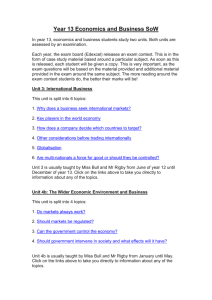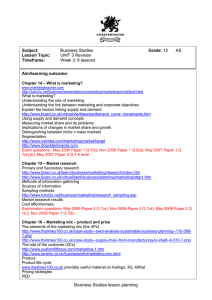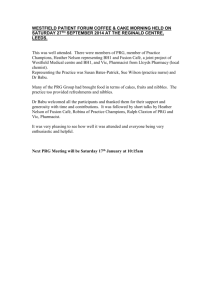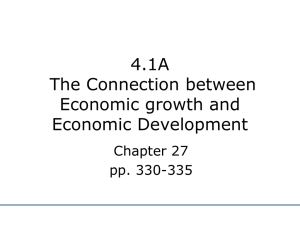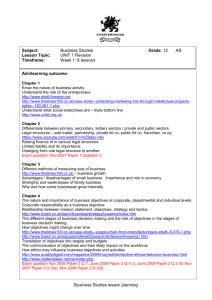Year 12 SoW – Economics and Business
advertisement
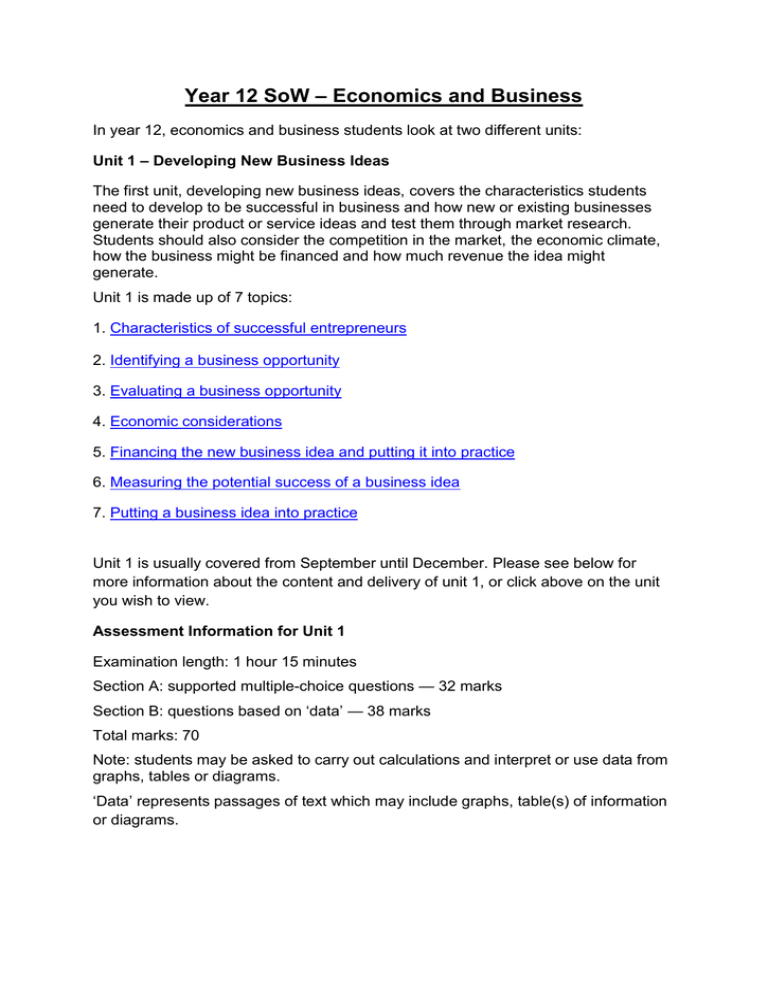
Year 12 SoW – Economics and Business In year 12, economics and business students look at two different units: Unit 1 – Developing New Business Ideas The first unit, developing new business ideas, covers the characteristics students need to develop to be successful in business and how new or existing businesses generate their product or service ideas and test them through market research. Students should also consider the competition in the market, the economic climate, how the business might be financed and how much revenue the idea might generate. Unit 1 is made up of 7 topics: 1. Characteristics of successful entrepreneurs 2. Identifying a business opportunity 3. Evaluating a business opportunity 4. Economic considerations 5. Financing the new business idea and putting it into practice 6. Measuring the potential success of a business idea 7. Putting a business idea into practice Unit 1 is usually covered from September until December. Please see below for more information about the content and delivery of unit 1, or click above on the unit you wish to view. Assessment Information for Unit 1 Examination length: 1 hour 15 minutes Section A: supported multiple-choice questions — 32 marks Section B: questions based on ‘data’ — 38 marks Total marks: 70 Note: students may be asked to carry out calculations and interpret or use data from graphs, tables or diagrams. ‘Data’ represents passages of text which may include graphs, table(s) of information or diagrams. Unit 2b – Business Economics The second unit, business economics, considers the market in which the business may be operating, how the level of competition in the market and macroeconomic change is likely to affect it and how businesses can seek to minimise uncertainty through their actions. Unit 2 is made up of 6 topics: 1. How businesses respond to their markets 2. How does market structure affect business? 3. What makes firms effective? 4. Businesses big and small 5. An uncertain future 6. How does macro-economic change affect business? Unit 1 is usually covered from January until May. Please see below for more information about the content and delivery of unit 2b, or click above on the unit you wish to view. Assessment information for Unit 2b Examination length: 1 hour 15 minutes Section A: supported multiple-choice questions — 24 marks Section B: questions based on ‘data’ — 46 marks Total marks: 70 Note: students may be asked to do calculations and interpret or use data from graphs, tables or diagrams. ’Data’ represents passages of text which may include graphs, table(s) of information or diagrams. Unit 1 – Developing New Business Ideas Topic 1: Characteristics of successful entrepreneurs Week Subject area Activity Resources September Characteristics of entrepreneurs Students to work in small groups to research definitions of entrepreneur, enterprise etc (see Activity sheet 1, Task 1.) Entrepreneurs Presentation ZBu (Ref. - Teaching Business & Economics, Volume 13 number 2, Summer 2009, page 11) Activity sheet 1, Task 1–3a. Students to discuss the contribution to the economy of well-known entrepreneurs (Activity sheet 1, Task 2). Case study on the importance of entrepreneurship at: www.thetimes100.co.uk/case _study.php?cID=63&csID=24 2&pID=1 See also Times 100 case study on the importance of entrepreneurship. Students should consider the characteristics of people who set up a new business (see Activity sheet 1, Task 3a.) Use a video of ‘The Apprentice’, ‘Dragons Den’, ‘Risking it All’, or another TV programme to illustrate this. Examples of ineffective entrepreneurs can also be informative. Video, of a TV programme, e.g. www.bbc.co.uk/apprentice/ www.bbc.co.uk/dragonsden/ www.channel4.com/money/o ntv/risking_it_all/ Additional reading: Students should consider whether or not they have sufficient entrepreneurial skills to set up their own business and, if not, how they could develop them (see Gillespie A — The Kwik-Fit Formula, Business Review, Volume 6, Issue 2, November 1999, pages 2-3 Wood S — Philip Green, Business Review, Activity Sheet 1, Task 3a.) Volume 10, Issue 2, November 2003, pages 34-35 Getting a New Business Off the Ground, Business Review, Volume 12, Issue 1, September 2005, pages 2-3 September What ZBu Motivates entrepreneurs? September Leadership ZBu styles Students should explore the profit and non-profit related motives of why people set up businesses, e.g. desire to work independently or from home. Some may start businesses for social purposes, e.g. an organic farm. (See Activity sheet 1, Task 3b.) Activity sheet 1, Task 3b Students should consider the various leadership styles, e.g. autocratic, democratic, that can be used and which are appropriate for different situations and skilled and unskilled staff. Students may reflect on their own preferred leadership style. (See also Activity sheet 1, Task 4.) Activity sheet 1, Task 4 Additional reading: Wood S — Michael O’Leary, Business Review, Volume 10, Issue 4, pages 2-3 PowerPoint and activity on leadership theory at: www.bized.co.uk/educators/1 6-19/business/ hrm/activity/leadertypes.htm Additional reading: Coates G — Top Secrets, Business Review, Volume 3, Issue 2, November 1996, pages 20-22. Kakabadse A — Life at the Top, Business Review, Volume 1, Issue 2, November 1994, pages 21-23 Topic 2: Identifying a business opportunity Week Subject area Activity Resources September What makes a market? Students could explore the changes in the market, and charges, for mobile phones — from when mobile phones were first available to now. What do they conclude about the interaction between price, supply and demand? Activity sheet 2, Task 1 and 2 PRg What should firms supply? Interaction activity and tasks on supply and demand at: www.bized.co.uk/educators/1619/economics/markets/activity/de mandsupply.htm (See Activity sheet 2, Task 1 and 2.) October PRg What consumers want or need Students should identify a market need for a business idea of their own. Activity sheet 2, Task 3 Students could gain new business ideas from, e.g. www.start-ups.co.uk. Additional reading: Why do they think that there is a potential demand for the business? This could be set as homework. Zhang L — Identifying a Market Opportunity, Business Review, Volume 7, Issue 4, April 2001, pages 2-4 Topic 3: Evaluating a business opportunity Week Subject area Activity Resources Teacher to define primary (quantitative and qualitative) and secondary research and why they are used, e.g. to quantify demand and gain insight into consumer behaviour. In addition, students can use a business textbook to define methods of research in Activity sheet 3, Task 1. Activity sheet 3, Tasks 1–2. November Researching demand for the business idea Teacher to identify problems that arise with small sample sizes; and the sampling method used, e.g. convenience sampling and potential bias. Market research methods at: PRg Visit to local business to determine the research methods they use and why. www.thetimes100.co.uk/theor y/theory.php?tID=315 Additional reading: Students could gain new business ideas from a website such as Marcousé I — Market Research, Business www.start-ups.co.uk. Review, Volume 6, Issue 1, September 1999, pages 18-20 It is a good idea for them to choose a product or service for which they can get a market summary (secondary data) on www.keynote.co.uk (see next topic.) They may carry out their own brief survey using quantitative and qualitative questions to ascertain demand for several business ideas. (See Activity sheet 3, Task 2.) November Is there a market for the business idea? PRg Market summaries for different product or service areas can be found on www.keynote.co.uk Activity Sheet 3, Task 2 Additional reading: Students can see the overall market size for their product or service area and whether the market is growing (see Activity Sheet 3, Task 2.) Please note that this topic could be taught before ‘Researching demand for the business idea’ — it has been separated so that the topics could be taught by two teachers simultaneously. Stimpson P — When Second Comes First, Business Review, Volume 10, Issue 1, September 2003, pages 22-24 Coates G — Customer Segmentation, Business Review, Volume 7, Issue 4, April 2001, pages 14-15 Using the respondent classification data from their questionnaires (see Activity sheet 3, Task 2) they may gain some market segmentation information for their potential customers, for example, gender and where they live. December PRg Positioning the business idea. Students could identify the market competition for their product or service idea; and the strengths and weaknesses of the competition. They could use market mapping to identify an appropriate market niche; and the competitive advantage of their product or service idea and how they will add value to it. Activity sheet 3, Task 3 Additional reading: Surridge M — Niche Markets, Business Review, Volume 9, Issue 4, April 2003, pages 2-3 December Product trial PRg Students could consider the benefits of trialling a product or service before it is launched, e.g. to assess likely demand levels: and how to turn the product trial into repeat purchases (see Activity Activity sheet 3, Task 2 sheet 3, Task 2.) Opportunity costs of developing one business idea as opposed to another From the results of their research, students could consider which business idea seems to have the most demand and the price (s) they could charge for the product or service. What are the trade-offs of going with one particular business idea (see Activity sheet 3, Task 3)? Additional reading: Students could use a case study to identify the potential effects on stakeholders of a decision by a business to offer a particular product or service. Zhang L — The Power of Stakeholders, Business Review, Volume 5, Issue 2, November 1998, pages 9–11 Topic 4: Economic considerations Week Subject area Activity Resources November Current economic Using the latest economic data, www.statistics.gov.uk students could analyse the potential effects of the latest economic trends on their new business idea (see Activity Activity sheet 4 sheet 4). The economic data should include: Additional reading: climate ZBu interest rates exchange rates inflation rates local or national unemployment figures. Boden A — Interest Rates, Business Review Volume 6, Issue 3, February 2000, pages 26-28 Boden A — UK Business in a Low Unemployment Environment, Business Review Volume 8, Issue 3, February 2002, page 20-22 Harrison S — Inflation, Business Review Volume 6, Issue 4, April 2000, pages 3031 Surridge M — The Price of Trading Internationally, Business Review Volume 11, Issue 4, April 2005, pages 8-9 Williams R — Exchange Rate, Business Review Volume 8, Issue 2, November 2001, pages 24-26 Topic 5: Financing the new business idea and putting it into practice Week Subject area Activity Resources ZBu Sources of finance The teacher should provide an input on: A guest speaker could be invited from a local bank to provide information on sources of finance which are commonly used by start-up businesses. October internal sources of finance: retained profit, sale of assets external sources of finance: loans, debentures, venture capital, ordinary share capital, overdrafts, leasing, trade credit sources of finance appropriate for sole trader and company organisations; implications of limited or unlimited liability. Activity sheet 5, Task 1 and 2 can be used for practical activities for students on sources of finance and how to apply the information learnt to their new business idea. Activity sheet 5, Task 1 and 2 Additional activities: www.bized.co.uk/virtual/bank/busi ness/finance/sources/theories1.ht m www.bized.co.uk/virtual/bank/busi ness/finance/sources/theories2.ht m www.bized.co.uk/educators/1619/business/accounting/activity/so urcefinance.htm Additional reading: Brewer M — Financing Growth, Business Review, Volume 3, Issue 4, April 1997, pages 23-25 ZBu October Sources of finance For their own new business idea, students could consider the total cost of a commercial loan and the loan repayment period from different financial Activity sheet 5, Task 3 and 4 providers. They could weigh this up against the benefit of a personal loan from family or friends and any resulting interference in the business. They should consider the implications of unlimited liability. Topic 6: Measuring the potential success of a business idea Week Subject area Activity Resources November Estimation of sales levels, costs and profits Students should try several exercises provided by the teacher to calculate revenue, variable costs, total costs and potential profit. Students may also need to practise identifying fixed costs. Activity sheet 6, Task 1–3 2012 ZBu Activity Sheet 6 (Task 1–3) uses a case study introducing revenue, fixed and variable costs and cash flow. November 2012 ZBu Break-even revenue level Activity Sheet 6 (Task 4–6) uses a case study to calculate breakeven. Teacher should introduce the concept of margin of safety. Activity sheet 6, Task 4–8 Additional activities: Students should be able to calculate basic profit and loss (sales revenue less deductions to identify gross and operating profit) and be able to calculate gross and operating profit margins. They should be able to comment on their calculations, such as identify ways in which the profit level could be improved. Activity Sheet 6 Task 7 enables students to prepare a profit and loss statement and identify ways in which profit level could be improved. Activity Sheet 6 Task 8 enables students to use pricing and cost http://www.bized.co.uk/virtual/ban k/business/planning/financial/step 1.htm www.bized.co.uk/virtual/bank/busi ness/planning/case_study.htm www.bized.co.uk/educators/1619/business/accounting/activity/fin ance1.htm Additional reading: Wolinski J — Simple Break-even Analysis, Business Review Volume 11, Issue 1, September information for their own business idea gathered by research to calculate breakeven level and potential profit. 2004, pages 10-12 Morris J — Improving Profitability, Business Review Volume 7, Issue 2, November 2000, pages 6-7 Topic 7: Putting a business idea into practice Week Subject area Activity Resources December Creation of a This topic can be introduced by using Activity sheet 7, perhaps as a homework activity. Activity sheet 7 business plan ZBu Sample business plans from local banks or the internet Teacher to cover the purpose of a business plan — to gain finance; the key features of a business plan: product or service to be produced; marketing plan; production plan; premises and equipment needed; human resources involved in implementing the business idea; sources of finance; profit and loss statement; cash flow forecast. For how to prepare business plans, see also: www.businesslink.gov.uk/bdot g/action/layer?topicId=107386 9162&r.s=sl Only a brief overview of this topic is necessary and it could be used to identify the topics already covered in Unit 1. Students could be given a business plan to evaluate. They do not need to construct one. Revision & Exam Preparation – December/January (2 weeks approx.) Unit 2b – Business Economics Topic 1: How businesses respond to their markets Week Subject area Activity Resources January The nature of markets Students should be encouraged to look at a wide range of markets and examples used to illustrate their dynamic nature. Activity sheet 1 — (newspapers/ magazines using research) PRg Additional reading: Swift I — Using Elasticity, Business Review Volume 8, Issue 3, February 2002, pages 32-33 Wall N — Responding to Market Change, Business Review Volume 10, Issue 3, February 2004, pages 32-33 January Changes in demand and supply The profit signalling mechanism and the allocation of resources. Activity sheet 1 Additional reading: Swift I — Using Elasticity, Business Review Volume 8, Issue 3, February 2002, pages 32-33 PRg Wall N — Using Price Theory to Analyse Market Change, Business Review Volume 11, Issue 3, February 2005, pages 30-31 January Changes in price PRg Students should consider how changes in demand and supply affect price and output and the implications of this for business. Practical examples are useful here and students should be encouraged to produce clear diagrams showing the effect of changes. Activity sheet 2 Additional resource: Interactive demand and supply model with PED application found at: www.bized.co.uk/learn/economics/ markets/mechanism/interactive/pa rt1.htm Additional reading: Swift I — Using Elasticity, Business Review Volume 8, Issue 3, February 2002, pages 32-33 Wall N — Using Price Theory to Analyse Market Change, Business Review Volume 11, Issue 3, February 2005, pages 30-31 Topic 2: How does market structure affect business? Week Subject area Activity Resources January How does Activity sheet 5 ZBu Competition affect the market? Students should consider the effect of the degree of competition on market price and output. Additional resources: www.thelongtail.com Students may be able to contribute their own experiences as to how markets have changed due to the development of ecommerce and online retailing, eg eBay, Amazon and iTunes. http://en.wikipedia.org/wiki/The_ Long_Tail Activity on understanding competition found at: http://www.bized.co.uk/learn/eco nomics/firms/structure/warpeace .htm The growth of e-tailing has, and will have, a profound effect on businesses and consumers alike, as supply and consumer knowledge increase. The ‘long tail’ can be used to illustrate this. January ZBu Different market structures: monopoly; oligopoly; imperfect and perfect competition and the spectrum of competition Students should consider the key characteristics of the different market structures which influence the way firms in the various markets behave. They should consider possible barriers to entry and exit in the market the likely effect on profit levels pricing promotion company efficiency and consumer choice of products. Activity sheet 6 Additional resource: Overview of monopoly found at: www.tutor2u.net/economics/revi sion-notes/as-marketfailurecompetition-monopoly.html Interactive quiz on monopoly found at: www.tutor2u.net/quiz/economics /jbc_econ_monopoly_1.htm Interactive quiz on perfect competition found at: www.tutor2u.net/quiz/economics /jbc_econ_perfectcompetition_1. htm Extension material on natural monopoly found at: www.tutor2u.net/economics/cont ent/topics/monopoly/natural_mo nopoly.htm Useful material on oligopoly found at: http://www.bized.co.uk/educator s/1619/economics/firms/activity/struc ture.htm More useful case studies for oligopoly can be found at: www.oligopolywatch.com Additional reading: Stimpson P — Markets and Competition, Business Review Volume 9, Issue 1, September 2002, pages 24-27 Mason T – The housing market and the economy, Economic Review, Volume 20, Number 3, February 2003, pages 2-5 Topic 3: What makes firms effective? Week Subject area Activity Resources February Different Students should look at the different types of organisational structures used by individual businesses. Activity sheet 7 types of ZBu organisational structures February How managers can get the ZBu best from staff February Productivity and efficiency ZBu Examples might include a traditional organisational structure for an organisation operating in an established market. In contrast, students should also look at the organisational structure of a company that has had to react rapidly to competitive threat or the changing demands of customers in its marketplace. Are the operations decentralised or are there less levels of management so that decision making can be quicker? Additional resources: www.bized.co.uk/learn/business/h rm/structures/index.htm http://www.bized.co.uk/educators/l evel2/people/activity/people12.htm www.thetimes100.co.uk/casestudy--meetingglobal-local-needs-89-236-1.php Company case studies could be used to examine how managers use delegation, consultation, empowerment, team working, flexible working and Total Quality Management to get the best from their staff. Students should consider when these techniques may not be effective and why they may be used by a firm operating in a rapidly changing market. Activity sheet 8 Students should consider how a business’s capacity utilisation (capital and labour) affects their ability to deal with market change. The implications of under and over utilisation of Activity sheet 9 Case studies at: www.times100.com capacity for the business and ways of improving capacity utilisation should also be covered. February Lean management ZBu Using a case study in the context of a business operating in a rapidly moving http://www.tutor2u.net/business/pr oduction/just-in-time.html market: http://www.tutor2u.net/business/pr oduction/time-basedmanagement-simultaneousengineering.html students should consider the advantages and disadvantages of Just in Time (JIT) management of stock the competitive advantage of short product development leadtimes the competitive advantage of minimising the waste of resources. Identify types of waste and potential ways of reducing it: http://www.tutor2u.net/business/pr oduction/introduction-to-leanproduction.html Business mini-case study: http://www.thetimes100.co.uk/theo ry/theory--lean-production-252.php Topic 4: Businesses big and small Week Subject area Activity Resources March Reasons It might be useful here to follow the changing nature of an industry over time, e.g. car manufacturing or food retailing, and use this to illustrate the theory. Both the above industries started out with many small firms and evolved into oligopolies with considerable market power. Activity sheet 10 Students should consider the implications for businesses of economies of scale and falling average cost (i.e. links to competitive advantage.) They also need to consider the minimum efficient scale and diseconomies of scale. Activity sheet 10 for bigger ZBu businesses — increased market share profitability, sales turnover and power March ZBu How increasing size affects costs Useful website: www.tescopoly.com Additional reading: Marcousé I — Does Size Matter?, Business Review Volume 6, Issue 3, February 2000, pages 24-25 Walsh J — Do Small Firms Create Jobs? Business Review Volume 5, Issue 2, November 1998, pages 16-18 Additional resources: More causes of economies and diseconomies of scale can be found at: www.investopedia.com/articles/03/ 012703.asp www.tutor2u.net/business/gcse/pr oduction_economies_of_scale.ht m www.tutor2u.net/business/gcse/pr oduction_diseconomies_of_scale. htm Additional reading: Harrison S — Economies of Scale , Business Review Volume 7, Issue 4, April 2001, pages 6-7 Leiper N — Economies of Scale: Christian Salvesen, Business Review Volume 9, Issue 3, February 2003, pages 24-26 Marcousé I — Does Size Matter?, Business Review Volume 6, Issue 3, February 2000, pages 24-25 Romer S — Why do Firms Merge?, Business Review Volume 4, Issue 3, February 1998, pages 12-13 March ZBu How size Students need to know the affects market characteristics of monopoly/ monopsony power effects of monopoly power on business and stakeholders and power the disadvantages and advantages of these types of power. Activity sheet 11 — useful websites are listed on the activity sheet Additional reading: Marcousé I — Does Size Matter?, Business Review Volume 6, Issue 3, February 2000, pages 24-25 Romer S — Why do Firms Merge?, Business Review Volume 4, Issue 3, February 1998, pages 12-13 March ZBu Small is beautiful Students need to know why small businesses exist and flourish despite a lack of economies of scale. Some small firms flourish by exploiting niche markets and developing e-tailing to access wider markets. There are many practical examples out there. Activity sheet 10 Additional reading: Cook M — Why Companies Choose to Shrink, Business Review Volume 7, Issue 4, April 2001, pages 32-33 Marcousé I — Does Size Matter?, Business Review Volume 6, Issue 3, February 2000, pages 24-25 Topic 5: An uncertain future Week Subject area Activity Resources March Causes of Students need to know some of the causes of uncertainty for business, e.g. 9/11, war or natural disaster an unexpected action by a competitor; macroeconomic change exchange rate movements and government intervention. Activity sheet 12 uncertainty PRg Additional reading: Eastcote N — Contingency Planning, Business Review Volume 12, Issue 4, April 2006, pages 8-10 Hammond A — Crisis Management, Business Review Volume 3, Issue 1, September 1996, pages 8-10 Lawell F — Change for Survival, Business Review Volume 11, Issue 3, February 2005, pages 1213 Catterall R – The Exchange Rate Roller Coaster, Teaching Business & Economics, Volume 8 Number 3, Autumn 2004, pages 38 March PRg Why uncertainty is a problem Students need to consider the potential effects of uncertainty on business planning and strategic decisions. They also need to understand that all businesses want to minimise uncertainty and risk. Activity sheet 12 Additional reading: Cottrell D — World Oil Crisis, Business Review, Volume 12, Issue 3, February 2006, pages 1213 Rapley P — Five Forces Analysis, Business Review Volume 12, Issue 2, November 2005, pages 32-34 Rees D — Business in the Next Recession, Business Review Volume 11, Issue 2, November 2004, pages 22-23 March How businesses can PRg try to reduce uncertainty Students need to know how businesses use the following to try to reduce uncertainty: macroeconomic indicators planning research and development (R and D) a market orientation and market research. It is important to stress that macroeconomic indicators and/or market research hold many pitfalls for the unwary business. Activity sheet 12 Additional reading: Eastcote N — Contingency Planning, Business Review Volume 12, Issue 4, April 2006, pages 8-10 Swift I — A Study in Contingency Planning, Business Review Volume 6, Issue 1, September 1999, pages 8-9 Topic 6: How does macro-economic change affect business? Week Subject area Activity Resources March What is the Students need to know the cycle of changes in growth and output of Gross Domestic Product. Through case studies, students should consider the implications for business of the stages of the economic cycle. They need to analyse why some businesses are affected more than others by the economic cycle, and in different ways. Activity sheet 13 Economic cycle? PRg Additional resources: For the latest data on economic trends: http://www.hmtreasury.gov.uk/home.htm http://www.hmtreasury.gov.uk/data_index.htm http://www.hmtreasury.gov.uk/data_forecasts_in dex.htm Real and nominal values. Additional reading: Wall N — Understanding the Business Cycle, Business Review Volume 2, Issue 2, November 1995, pages 21-23 March PRg How does Inflation affect us all? Students need to know how inflation contributes to business uncertainty redistribution of wealth loss of competitiveness and skills shortages. Activity sheet 14 Additional resources: Interactive quiz on the costs of inflation: http://www.bized.co.uk/virtual/ban k/economics/mpol/inflation/costs/q uiz1.htm A worksheet on the cost of inflation: http://www.bized.co.uk/virtual/ban k/economics/mpol/inflation/costs/w orksheet1.htm Additional reading: Harrison S — Inflation, Business Review, Volume 6, Issue 4, April 2000, pages 30-31 April What is PRg Unemploymen t and how does it affect us all? Students need to know the different types of unemployment, its costs to the economy, the opportunity and social costs. Activity sheet 15 Additional resource: A search for structural change on www.hm-treasury.gov.uk provides some useful material. The changing nature of employment involves not just changes in occupational trends but also changes in who works and how we work. Additional reading: Boden A — UK Business in a Low Unemployment Environment, Business Review, Volume 8, Issue 3, February 2002, pages 20-22 Students need to appreciate that economies are in a constant state of change and that the resultant structural changes have far reaching consequences for business. A look at how employment in the local area has changed over the last 50 years would be useful. Students should also consider how the nature of local businesses has changed. April PRg What is structural change? Students need to consider the development of an economy over time the changing nature of employment and output patterns. Activity sheet 15 Additional reading: Boden A — Economic Growth, Business Review, Volume 9, Issue 1, September 2002, pages 28-30 April What are the Implications for business? PRg Students need to consider how a business may respond and adapt to changes in the economy the implications of changes for the future and the rise of the knowledge economy. Activity sheet 15 Additional resource: For information on the knowledge economy: www.esrcsocietytoday.ac.uk/ESR CInfoCentre/facts/index4.aspx Additional reading: Boden A — Economic Growth, Business Review, Volume 11, Issue 1, September 2004, pages 34-37 Revision & Exam Preparation – April – mid-May (4 weeks approx.)
